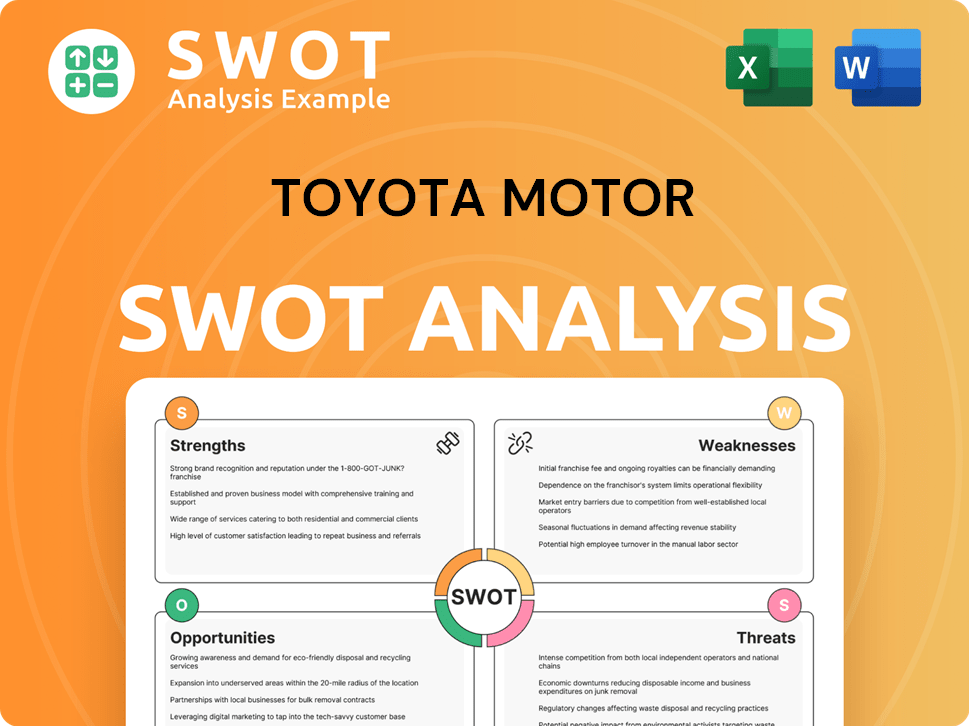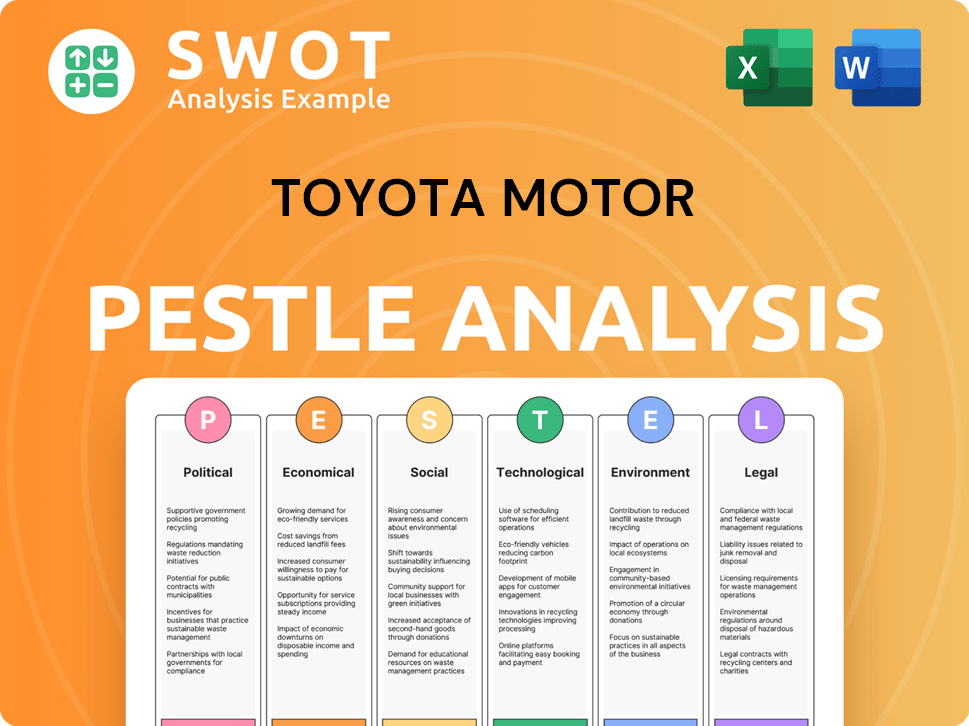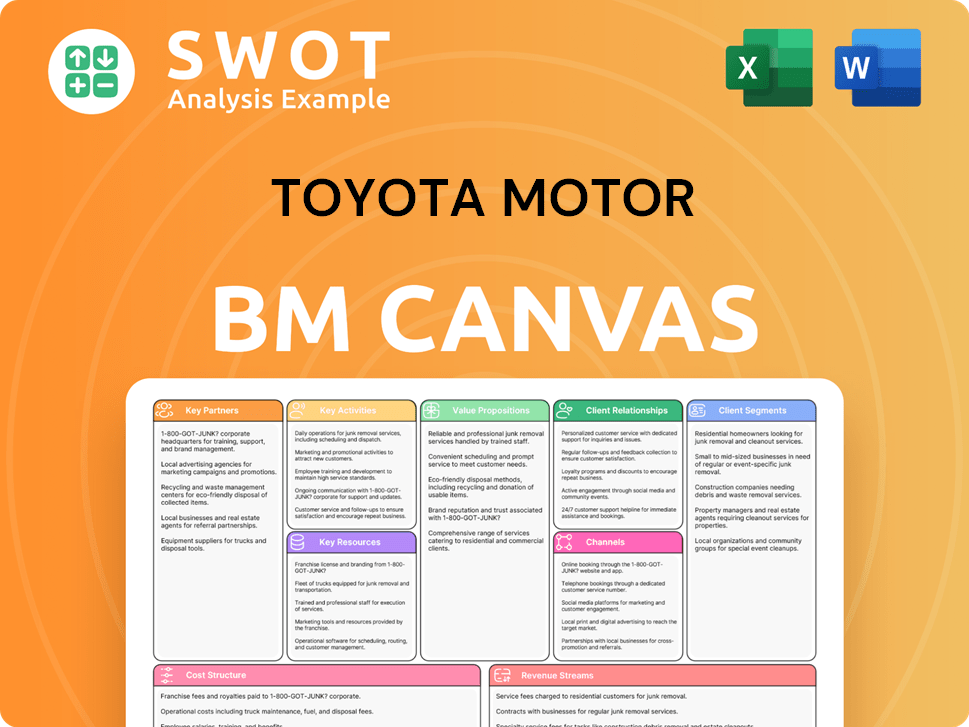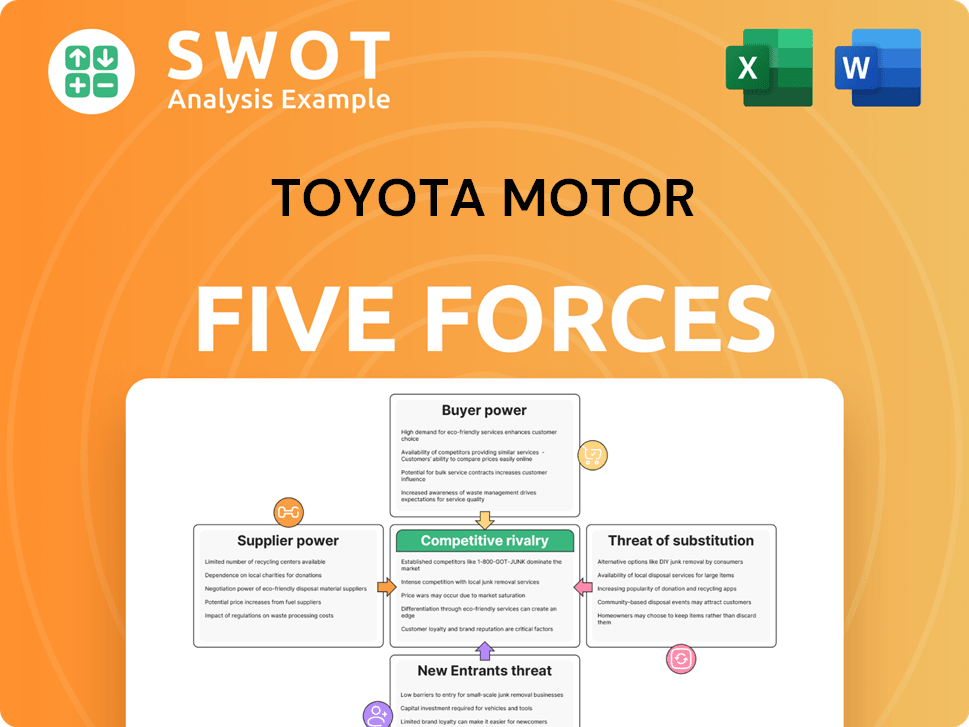Toyota Motor Bundle
Can Toyota Maintain Its Dominance in the Automotive Arena?
Toyota, a titan of the automotive industry since 1937, continues to evolve and compete in a dynamic global market. With record-breaking revenue in fiscal year 2024 and a strong focus on sustainable mobility, Toyota's strategic moves are constantly reshaping the sector. This analysis dives into the Toyota Motor SWOT Analysis, exploring its competitive landscape and future prospects.

Understanding Toyota's competitive landscape is crucial for investors and industry watchers alike. This report provides a comprehensive Toyota market analysis, examining its key Toyota competitors and strategic positioning within the automotive industry. We'll delve into Toyota's strategy, evaluating its strengths and weaknesses to provide actionable insights into its global competitive positioning and future market outlook, including its electric vehicle competition.
Where Does Toyota Motor’ Stand in the Current Market?
Toyota Motor Corporation holds a significant position in the global automotive industry, consistently ranking among the top automakers worldwide. The company's success is underpinned by its diverse product offerings, robust sales figures, and strategic geographic presence. This strong market position is a result of its ability to adapt to various market demands and maintain a competitive edge.
In 2024, Toyota demonstrated strong performance across key markets. Toyota Motor Europe (TME) achieved record sales, while Toyota Motor North America (TMNA) saw increased sales, particularly in the electric vehicle segment. These achievements highlight Toyota's effective strategies in different regions and its ability to meet evolving consumer preferences.
Toyota's core operations involve the design, manufacturing, and sale of passenger cars, minivans, commercial vehicles, and related parts. The company also provides financial services, including retail auto loans and leasing. This comprehensive approach allows Toyota to capture value across the automotive value chain and maintain a strong market presence. For a deeper understanding of how Toyota has achieved its success, consider exploring the Growth Strategy of Toyota Motor.
In 2024, Toyota Motor Europe (TME) achieved a 7.1% market share in Europe. The Toyota brand secured its position as the second best-selling passenger car brand in Europe for the fourth consecutive year. This sustained performance indicates strong consumer confidence and effective market strategies.
Toyota Motor North America (TMNA) reported U.S. sales of 2,332,623 vehicles in 2024, marking a 3.7% increase compared to 2023. The company's focus on electric vehicles is evident, with electrified vehicle sales comprising over 50% of total sales volume by Q1 2025.
Toyota reported record revenue of 45.09 trillion yen in fiscal year 2024. While operating income decreased in FY2025 by 10.4% to 4,795.5 billion yen, the financial services operations saw significant growth. Sales revenues increased by 28.6%, and operating income rose by 19.9% in FY2025.
Toyota operates in over 170 countries and regions, which allows it to adapt to diverse market demands. In Thailand, Toyota held a 38.5% market share in 2024, selling 220,356 vehicles. The company aims to maintain this share in 2025 with a projected sales increase of 5% to 231,000 units.
Toyota's competitive landscape is shaped by its ability to offer a diverse product line, strong financial performance, and strategic geographic presence. The company's focus on hybrid and electric vehicles positions it well for future market trends. Toyota's main rivals in the US include other Japanese automakers and global companies.
- Diverse Product Portfolio: Offering a wide range of vehicles to meet various consumer needs.
- Strong Financial Performance: Consistent revenue and profitability, enabling investments in R&D.
- Global Presence: Operating in over 170 countries, allowing adaptation to local market demands.
- Focus on Electrification: Increasing sales of hybrid and electric vehicles to meet future demands.
Toyota Motor SWOT Analysis
- Complete SWOT Breakdown
- Fully Customizable
- Editable in Excel & Word
- Professional Formatting
- Investor-Ready Format

Who Are the Main Competitors Challenging Toyota Motor?
The Owners & Shareholders of Toyota Motor face a dynamic and multifaceted competitive landscape. The automotive industry is fiercely contested, with numerous global players vying for market share. Understanding the key competitors is crucial for evaluating Toyota's strategic positioning and future prospects.
Toyota's competitive environment includes both direct and indirect rivals. Direct competitors are other major automakers, while indirect competitors include emerging players and those in adjacent industries. The rise of electric vehicles (EVs) and evolving consumer preferences further complicate the competitive dynamics.
Toyota's market analysis reveals a complex web of competitors, each with its own strengths and strategies. The company must continuously adapt to maintain its position in the global automotive market.
Key direct competitors include established automotive giants. These companies compete directly with Toyota across various vehicle segments and geographic markets. The competition is intense, with each automaker striving to capture a larger share of the global market.
Volkswagen is a major rival, often competing with Toyota for the top spot in global sales. In 2024, Volkswagen's global sales reached approximately 8.5 million vehicles. The group's diverse portfolio, including brands like Audi and Porsche, allows it to compete across various market segments.
GM is another significant competitor, particularly in the North American market. In 2024, GM's sales in the United States were approximately 2.5 million vehicles. The company's focus on trucks and SUVs provides a strong competitive position.
Ford competes strongly, especially in the truck and SUV segments. Ford's sales in the U.S. in 2024 were around 1.9 million vehicles. The company's investments in electric vehicles are also increasing the competitive pressure.
Honda is a key competitor, known for its reliability and fuel efficiency. In 2024, Honda's global sales reached approximately 4 million vehicles. The company's hybrid technology and strong brand reputation are significant competitive advantages.
Nissan competes in various segments, including electric vehicles with the LEAF model. Nissan's global sales in 2024 were about 3.4 million vehicles. The company's strategic partnerships and global presence are critical.
Hyundai-Kia has rapidly increased its market share through competitive pricing and innovative designs. Combined sales in 2024 were approximately 6.5 million vehicles. Their focus on value and technology makes them formidable competitors.
Stellantis, formed from the merger of Fiat Chrysler Automobiles and PSA Group, is a major player with a wide range of brands. Stellantis sold approximately 6.1 million vehicles globally in 2024. The merger has expanded its product portfolio and market reach.
The automotive industry's competitive landscape is also significantly impacted by the rise of electric vehicles (EVs). These companies are challenging traditional automakers with new technologies and business models. Toyota's strategy must consider these emerging players to maintain its market position.
The shift towards electric vehicles has introduced new competitors. These companies are driving innovation in battery technology, software, and autonomous driving.
- Tesla: Tesla is a leader in the EV market, with a strong brand and advanced technology. In 2024, Tesla delivered approximately 1.8 million vehicles. Their focus on innovation and direct-to-consumer sales has disrupted the industry.
- Rivian Automotive: Rivian focuses on electric trucks and SUVs. The company has a strong brand in the EV pickup truck segment.
- Li Auto, XPeng, NIO Inc., Polestar: These companies are rapidly growing in the EV market, particularly in China. They are investing heavily in new technologies and expanding their product lines.
Toyota Motor PESTLE Analysis
- Covers All 6 PESTLE Categories
- No Research Needed – Save Hours of Work
- Built by Experts, Trusted by Consultants
- Instant Download, Ready to Use
- 100% Editable, Fully Customizable

What Gives Toyota Motor a Competitive Edge Over Its Rivals?
The Target Market of Toyota Motor Company's competitive advantages are rooted in its commitment to quality, efficiency, and innovation. These strengths enable it to maintain a strong position within the automotive industry. Understanding the Toyota competitive landscape requires a deep dive into these core areas.
Toyota's success is built on the Toyota Production System (TPS), which focuses on waste reduction and continuous improvement. This system allows for high-quality vehicle production at lower costs. Brand equity and customer loyalty are also significant factors, with a reputation for durable and reliable vehicles. Toyota's global presence and robust supply chain further enhance its competitive edge.
Toyota's strategic focus on research and development (R&D) is another key advantage, particularly in environmentally friendly vehicle technologies, vehicle safety, and information technology. Toyota's multi-pathway approach to carbon neutrality, encompassing hybrid electric vehicles (HEVs), plug-in hybrid electric vehicles (PHEVs), battery electric vehicles (BEVs), and fuel cell electric vehicles (FCEVs), demonstrates its commitment to offering diverse sustainable solutions.
The TPS is a cornerstone of Toyota's efficiency, emphasizing waste elimination and continuous improvement. This system allows Toyota to produce vehicles at lower costs. It ensures high-quality manufacturing, which contributes to the company's competitive pricing strategy.
Toyota has built a strong reputation for producing durable and reliable vehicles. High customer retention rates are a direct result of this reputation. In a 2025 UK survey, 75% of Toyota owners expressed a preference for another Toyota vehicle when replacing their car.
Toyota's extensive global presence and efficient supply chain provide a significant competitive edge. Manufacturing facilities in numerous countries allow for quick responses to regional demands. This global footprint helps minimize transportation costs.
Toyota's strategic focus on R&D is a key advantage, particularly in environmentally friendly vehicle technologies. The company is investing heavily in vehicle safety and information technology. By 2025, Toyota aims to have no fewer than 70 products in its global electrified portfolio.
Toyota's competitive advantages include the TPS, strong brand equity, global presence, and R&D investments. These elements contribute to its success in the automotive industry. Understanding these factors is crucial for a thorough Toyota market analysis.
- Toyota Production System (TPS): Ensures efficient, high-quality, and cost-effective manufacturing.
- Brand Reputation: Builds customer loyalty through durable and reliable vehicles.
- Global Footprint: Enables efficient production and distribution worldwide.
- R&D Focus: Drives innovation in sustainable and advanced vehicle technologies.
Toyota Motor Business Model Canvas
- Complete 9-Block Business Model Canvas
- Effortlessly Communicate Your Business Strategy
- Investor-Ready BMC Format
- 100% Editable and Customizable
- Clear and Structured Layout

What Industry Trends Are Reshaping Toyota Motor’s Competitive Landscape?
The automotive industry is experiencing significant shifts, driven by technological advances, evolving consumer preferences, and stringent regulations. This dynamic environment presents both challenges and opportunities for companies like Toyota. Understanding the Toyota competitive landscape is crucial for investors and strategists navigating the sector. Analyzing Toyota market analysis and the strategies of its rivals is key to anticipating future trends and making informed decisions.
Toyota's position is influenced by its historical strengths in hybrid technology, its ongoing transition to electric vehicles (EVs), and the competitive pressure from both traditional automakers and new entrants like Tesla. The company faces risks related to the speed of EV adoption, supply chain disruptions, and the need to adapt to software-defined vehicles. The future outlook for Toyota depends on its ability to innovate, expand into new markets, and forge strategic partnerships to maintain its leadership in the automotive industry.
The automotive sector is undergoing a rapid transformation, with electrification leading the charge. Consumer demand for EVs is increasing, and regulatory pressures are pushing for reduced emissions. The development of autonomous driving technology and software-defined vehicles is another critical trend shaping the industry.
Toyota faces challenges in the EV market, where competitors like Tesla have gained significant market share. Lagging in autonomous driving technology also poses a hurdle. Meeting emission reduction targets and adapting to software-defined vehicles requires substantial investment and strategic agility.
Opportunities for Toyota include expanding into emerging markets and continuing product innovation. Strategic partnerships and advancements in hydrogen fuel cell technology offer further growth potential. The company's global adaptability and strong brand loyalty are key advantages.
Toyota is focusing on expanding its BEV and PHEV lineup, aiming for seven EVs by 2027, with new models planned for both Europe and the US. Investing heavily in battery production, with a new plant in North Carolina set to begin shipping lithium-ion cells in late 2025, supporting up to 300,000 EVs annually. Exploring commercial applications of hydrogen technology and strategic collaborations are also key components of its strategy.
Toyota's success hinges on its ability to navigate the transition to EVs, compete in the autonomous driving space, and adapt to evolving consumer demands. The company's multi-pathway approach, including hybrid technology, BEVs, and fuel cell vehicles, is designed to address these challenges. Strategic partnerships and investments in battery production are crucial for future growth.
- Electrification: Expanding its BEV and PHEV lineup, with plans to introduce six new BEVs in Europe by 2026 and two new US-made EVs in 2025.
- Battery Production: Investing in battery production, with a new plant in North Carolina set to begin shipping lithium-ion cells in late 2025, supporting up to 300,000 fully electric vehicles annually.
- Autonomous Driving: Investing in AI for autonomous vehicles to remain competitive in future mobility solutions.
- Hydrogen Technology: Exploring commercial applications of hydrogen technology for heavy-duty trucks and buses, identifying fuel cell vehicles as having a key competitive advantage.
Analyzing Toyota's market share analysis reveals its strong position in several global markets, but also highlights the need to adapt to the rapidly changing Toyota competitive landscape. For instance, Toyota's sales in North America in 2023 were approximately 2.2 million units, indicating a strong presence, but the rise of competitors like Tesla requires continuous innovation. Toyota's strategy, as detailed in the Marketing Strategy of Toyota Motor, emphasizes a multi-pronged approach to address the challenges and capitalize on opportunities. This includes a focus on hybrid technology, expansion of its EV lineup, and strategic partnerships to maintain its competitive edge. Understanding Toyota's main rivals in the US and globally, such as Tesla, Honda, and other Japanese automakers, is essential for a comprehensive Toyota vs Honda comparison and assessing Toyota's competitive advantages. Toyota's strengths and weaknesses analysis shows its robust financial performance and brand reputation, balanced by challenges in the rapidly evolving EV market and the need to invest in autonomous driving technologies. Toyota's future market outlook depends on its ability to adapt to these shifts, optimize its pricing strategy analysis, and effectively compete with rivals. The company's investment in diverse technologies, including fuel cell vehicles and synthetic fuels, positions it for long-term resilience, despite potential threats from declining demand in certain segments or new competitors. The company's diverse approach to technology, along with its focus on customer-centric solutions, positions it for continued leadership in the evolving automotive industry.
Toyota Motor Porter's Five Forces Analysis
- Covers All 5 Competitive Forces in Detail
- Structured for Consultants, Students, and Founders
- 100% Editable in Microsoft Word & Excel
- Instant Digital Download – Use Immediately
- Compatible with Mac & PC – Fully Unlocked

Related Blogs
- What are Mission Vision & Core Values of Toyota Motor Company?
- What is Growth Strategy and Future Prospects of Toyota Motor Company?
- How Does Toyota Motor Company Work?
- What is Sales and Marketing Strategy of Toyota Motor Company?
- What is Brief History of Toyota Motor Company?
- Who Owns Toyota Motor Company?
- What is Customer Demographics and Target Market of Toyota Motor Company?
Disclaimer
All information, articles, and product details provided on this website are for general informational and educational purposes only. We do not claim any ownership over, nor do we intend to infringe upon, any trademarks, copyrights, logos, brand names, or other intellectual property mentioned or depicted on this site. Such intellectual property remains the property of its respective owners, and any references here are made solely for identification or informational purposes, without implying any affiliation, endorsement, or partnership.
We make no representations or warranties, express or implied, regarding the accuracy, completeness, or suitability of any content or products presented. Nothing on this website should be construed as legal, tax, investment, financial, medical, or other professional advice. In addition, no part of this site—including articles or product references—constitutes a solicitation, recommendation, endorsement, advertisement, or offer to buy or sell any securities, franchises, or other financial instruments, particularly in jurisdictions where such activity would be unlawful.
All content is of a general nature and may not address the specific circumstances of any individual or entity. It is not a substitute for professional advice or services. Any actions you take based on the information provided here are strictly at your own risk. You accept full responsibility for any decisions or outcomes arising from your use of this website and agree to release us from any liability in connection with your use of, or reliance upon, the content or products found herein.